Simulation models often only illuminate individual facets of an overall system. If they are coupled, the investigated systems can be mapped in more detail by including the interactions of these different aspects. The significance of individual source, transport and conversion processes of aerosols and trace gases as well as their interaction with radiation and clouds can only be estimated by integrating corresponding process descriptions into regional and global atmospheric models. Model coupling is at the beginning of cross-scale simulations – from particle formation to intercontinental propagation and from drop activation to precipitation formation.
TROPOS is working on the coupling of several model systems on a regional and global scale. Preliminary numerical work includes the investigation of different strategies for online coupling and load balancing. The coupling schemes are intended to ensure a high degree of flexibility as well as feedback effects between the models. The key to this is a high degree of modularization. The aim is also to make the best possible use of the infrastructure of the host model, e.g. for input and output, with a minimum of interventions in the host model and separate data structures.
ECHAM-HAMMOZ and ICON-HAM
The aerosol-chemistry-climate model ECHAM-HAMMOZ is used to investigate the interactions between climate and aerosols. ECHAM-HAMMOZ is being developed by an international consortium currently led by TROPOS. Our focus is primarily on the further development of aerosol parameterizations. We are helping to shape the transition to the new aerosol climate model ICON-A-HAM2.3, in which the aerosol module HAM2.3 is coupled to the new atmospheric general circulation model ICON-A. Within the HAMMOZ community, the ICON interface for the aerosol chemistry and microphysics package HAM was implemented, led by work at the Leipzig Institute of Meteorology (LIM).
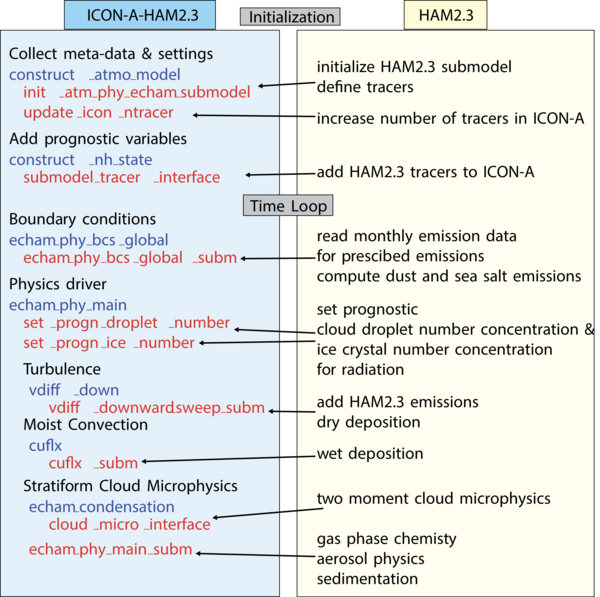
Schematic representation of the coupling of the aerosol module HAM2.3 to the climate model ICON-A via the submodel interface with the names of the HAM2.3 interface routines (red) and the ICON-A routines/entry points. Marc Salzmann (LIM, University of Leipzig).
COSMO-MUSCAT and ICON-MUSCAT
The MUltiSCale chemistry Aerosol Transport model MUSCAT developed at TROPOS was coupled to the former operational weather model of the German Weather Service DWD. COSMO-MUSCAT describes the dynamics and conversion of aerosol particles and relevant trace gases and enables the feedback of modeled aerosol to cloud formation and radiation. The online coupled model system has been successfully used for more than 15 years for air quality applications and process studies, e.g. for the investigation of secondary aerosol formation, multiphase chemistry as well as aerosol cloud and radiation interactions. In the meantime, a model version exists in which MUSCAT is coupled with the current forecast version of the weather and climate model ICON. MUSCAT uses its own data structure and separate time step control, designed analogous to the ICON. The ICON host model uses parts of the infrastructure such as the grid, online nesting, and routines for input and output, management, and processing. After the first air quality simulations with detailed gas-phase chemistry have been realized, the development focuses in particular on the performance optimization and evaluation of ICON-MUSCAT. The feedback modeled aerosol cloud microphysics and radiation is to be implemented in a next step.
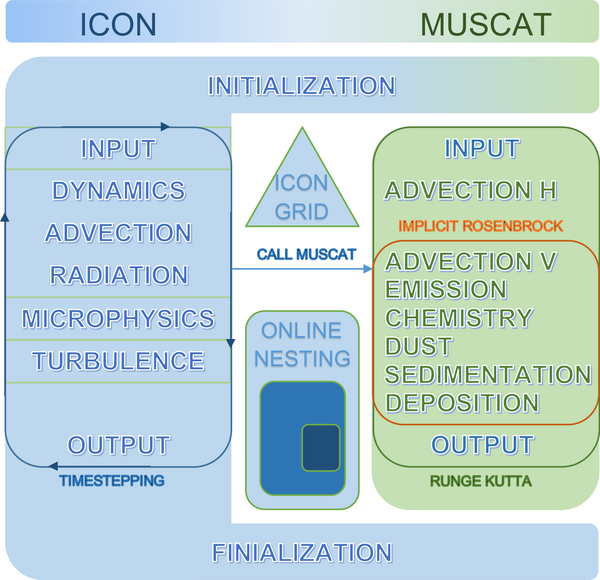
Coupling scheme of the multiscale chemistry transport model ICON-MUSCAT. ICON part with time integration loop within which the MUSCAT interface is called (blue). Processes in ICON with interfaces to the MUSCAT model structure (outlined in green). MUSCAT part with split time integration (green). A Runge Kutta method and a Rosenbrock method for the implicit part (outlined in orange) are used.
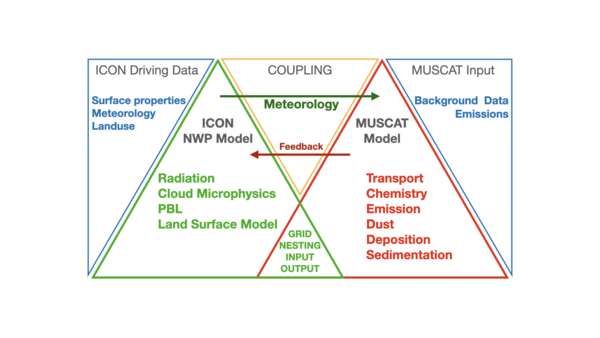
Schematic of the ICON-MUSCAL model coupling.
ICON-GETM
The coastal buoyancy and air-sea fluxes of impulse are strongly influenced by the reduced sea surface temperature, with significant feedbacks from the upper ocean to the lower atmosphere. The investigation of these dynamic feedbacks with quantitative effects on the predictability of coastal oceanic and regional atmospheric model systems requires a coupled ocean-atmosphere model. With a geographical focus on the western Baltic Sea, the two-way-coupled atmosphere-ocean model ICON-GETM was developed in cooperation with the Leibniz Institute for Baltic Sea Research Warnemünde (IOW). ICON-GETM is based on the latest coupling software NUOPC with flexible data exchange and conservative interpolation via ESMF exchange grids. In a first application, a complex and episodic buoyancy event in the western Baltic Sea in the summer of 2012 was simulated and analyzed.
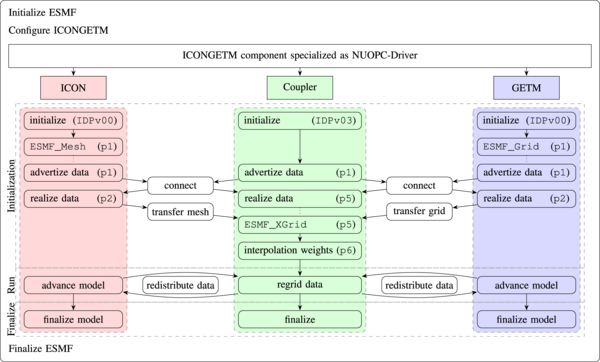
Structure of the coupled atmosphere-ocean model ICON-GETM.
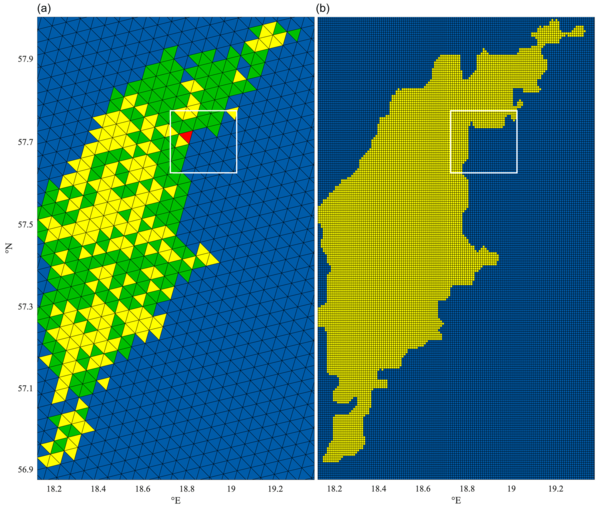
The grids of the atmospheric model ICON (left, 2.5 km grid width) and the ocean model GETM (right, 600 m grid width), which are coupled via ESMF exchange grids and the coupling software NUOPC.



